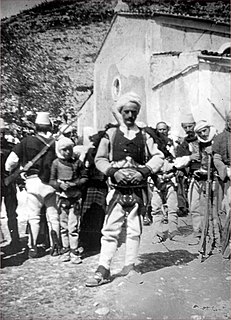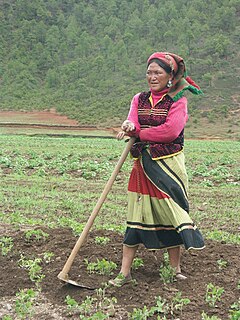Related Research Articles

The term tribe is used in many different contexts to refer to a category of human social group. The predominant usage of the term is in the discipline of anthropology. The definition is contested, in part due to conflicting theoretical understandings of social and kinship structures, and also reflecting the problematic application of this concept to extremely diverse human societies. The concept is often contrasted by anthropologists with other social and kinship groups, being hierarchically larger than a lineage or clan, but smaller than a chiefdom, nation or state. These terms are equally disputed. In some cases tribes have legal recognition and some degree of political autonomy from national or federal government, but this legalistic usage of the term may conflict with anthropological definitions.
Matrilineality is the tracing of kinship through the female line. It may also correlate with a social system in which each person is identified with their matriline – their mother's lineage – and which can involve the inheritance of property and/or titles. A matriline is a line of descent from a female ancestor to a descendant in which the individuals in all intervening generations are mothers – in other words, a "mother line". In a matrilineal descent system, an individual is considered to belong to the same descent group as their mother. This ancient matrilineal descent pattern is in contrast to the currently more popular pattern of patrilineal descent from which a family name is usually derived. The matriline of historical nobility was also called their enatic or uterine ancestry, corresponding to the patrilineal or "agnatic" ancestry.
A clan is a group of people united by actual or perceived kinship and descent. Even if lineage details are unknown, clan members may be organized around a founding member or apical ancestor. Clans, in indigenous societies, tend to be endogamous, meaning that their members can marry one another. Clans preceded more centralized forms of community organization and government, and exist in every country. Members may identify with a coat of arms or other symbol to show that they are an independent clan. The kinship-based bonds may also have a symbolic ancestor, whereby the clan shares a "stipulated" common ancestor that is a symbol of the clan's unity. When this "ancestor" is non-human, it is referred to as a totem, which is frequently an animal.

In anthropology, kinship is the web of social relationships that form an important part of the lives of all humans in all societies, although its exact meanings even within this discipline are often debated. Anthropologist Robin Fox states that "the study of kinship is the study of what man does with these basic facts of life – mating, gestation, parenthood, socialization, siblingship etc." Human society is unique, he argues, in that we are "working with the same raw material as exists in the animal world, but [we] can conceptualize and categorize it to serve social ends." These social ends include the socialization of children and the formation of basic economic, political and religious groups.
In social anthropology, matrilocal residence or matrilocality is the societal system in which a married couple resides with or near the wife's parents. Thus, the female offspring of a mother remain living in the mother's house, thereby forming large clan-families, typically consisting of three or four generations living in the same place.
George Peter ("Pete") Murdock, also known as G. P. Murdock, was an American anthropologist. He is remembered for his empirical approach to ethnological studies and his study of family and kinship structures across differing cultures. His 1967 Ethnographic Atlas dataset on more than 1,200 pre-industrial societies is influential and frequently used in social science research.
Iroquois kinship is a kinship system named after the Haudenosaunee people that were previously known as Iroquois and whose kinship system was the first one described to use this particular type of system. Identified by Lewis Henry Morgan in his 1871 work Systems of Consanguinity and Affinity of the Human Family, the Iroquois system is one of the six major kinship systems.
Eskimo kinship or Inuit kinship is a category of kinship used to define family organization in anthropology. Identified by Lewis Henry Morgan in his 1871 work Systems of Consanguinity and Affinity of the Human Family, the Eskimo system was one of six major kinship systems. The system of English-language kinship terms falls into the Eskimo type.
Crow kinship is a kinship system used to define family. Identified by Lewis Henry Morgan in his 1871 work Systems of Consanguinity and Affinity of the Human Family, the Crow system is one of the six major kinship systems.
Ambilineality is a form of kinship affiliation of cognatic descent that relies on self-defined affiliation within a given social system. Meaning individuals have the choice to be affiliated with their mother’s or father’s group. Common features of societies that practice ambilineality are a shared set of land, communal responsibilities, and collective ownership of some segments of wealth and debt in their societies. This system of descent is distinct from more common genealogical structures in that rather than determining affiliation and descent using the standard determinants of biological and genealogical relation, it instead relies heavily on voluntary affiliation with one's group, oftentimes being determined by factors including residence.
Omaha kinship is the system of terms and relationships used to define family in Omaha tribal culture. Identified by Lewis Henry Morgan in his 1871 work Systems of Consanguinity and Affinity of the Human Family, the Omaha system is one of the six major kinship systems which he identified internationally.
The avunculate, sometimes called avunculism or avuncularism, is any social institution where a special relationship exists between an uncle and his sisters' children. This relationship can be formal or informal, depending on the society. Early anthropological research focused on the association between the avunculate and matrilineal descent, while later research has expanded to consider the avunculate in general society.
In the tribal law of the Noongar, an indigenous Australian people, a kinship classification system determined descent and inheritance, and enforced restrictions on intermarriage between certain groups.
Kinship terminology is the system used in languages to refer to the persons to whom an individual is related through kinship. Different societies classify kinship relations differently and therefore use different systems of kinship terminology; for example, some languages distinguish between consanguine and affinal uncles, whereas others have only one word to refer to both a father and his brothers. Kinship terminologies include the terms of address used in different languages or communities for different relatives and the terms of reference used to identify the relationship of these relatives to ego or to each other.
Eleanor Kathleen Gough Aberle was a British anthropologist and feminist who was known for her work in South Asia and South-East Asia. As a part of her doctorate work, she did field research in Malabar district from 1947 to 1949. She did further research in Tanjore district from 1950 to 1953 and again in 1976, and in Vietnam in 1976 and 1982. In addition, some of her work included campaigning for: nuclear disarmament, the civil rights movement, women's rights, the third world and the end of the Vietnam War. She was known for her Marxist leanings and was on an FBI watchlist.

The Mosuo are a small ethnic group living in Yunnan and Sichuan provinces in China, close to the border with Tibet. Dubbed the 'Kingdom of Women' by the Chinese, the Mosuo population of about 50,000 live near Lugu Lake in the Tibetan Himalayas 27°42′35.30″N100°47′4.04″E.
In the anthropological study of kinship, a moiety is a descent group that coexists with only one other descent group within a society. In such cases, the community usually has unilineal descent so that any individual belongs to one of the two moiety groups by birth, and all marriages take place between members of opposite moieties. It is an exogamous clan system with only two clans.

In anthropology, a house society is a society where kinship and political relations are organized around membership in corporately-organized dwellings rather than around descent groups or lineages, as in the "House of Windsor". The concept was originally proposed by Claude Lévi-Strauss who called them "sociétés à maison". The concept has been applied to understand the organization of societies from Mesoamerica and the Moluccas to North Africa and medieval Europe.
Detailed anthropological and sociological studies have been made about customs of patrilineal inheritance, where only male children can inherit. Some cultures also employ matrilineal succession, where property can only pass along the female line, most commonly going to the sister's sons of the decedent; but also, in some societies, from the mother to her daughters. Some ancient societies and most modern states employ egalitarian inheritance, without discrimination based on gender and/or birth order.
The Tjial were an indigenous Australian people of the Northern Territory who are now extinct.
References
- Oxford English Dictionary. XV (2nd ed.). Clarendon Press. 1989.
- Fox, Robin (1967). Kinship and Marriage . Penguin.
- Berreman, Gerald D. (October 1962). "Sib and Clan among the Pahari of North India". Ethnology. University of Pittsburgh. 1 (4): 524–528. doi:10.2307/3772855. JSTOR 3772855.
- Lowie, Robert H. (January 1919). "Family and Sib". American Anthropologist. Blackwell Publishing on behalf of the American Anthropological Association. 21 (1): 28–40. doi: 10.1525/aa.1919.21.1.02a00030 .
- Lessells, C. M.; G. A. Parker (August 1999). "Parent-Offspring Conflict: The Full-Sib-Half-Sib Fallacy". Biological Sciences. The Royal Society. 266 (1429): 1637–1643. doi:10.1098/rspb.1999.0826. PMC 1690187 .